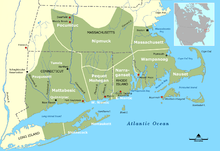 The Quinnipiac River looking west into the Quinnipiac River Gorge | |
| Total population | |
|---|---|
| extinct as a tribe; merged into the Stockbridge Munsee Community and Brotherton Indian Community, now in Wisconsin[1] | |
| Regions with significant populations | |
| United States (Connecticut) | |
| Languages | |
| Quiripi language | |
| Religion | |
| Indigenous religion | |
| Related ethnic groups | |
| other Wappinger peoples |
The Quinnipiac were a historical Indigenous people of the Northeastern Woodlands. They lived in present-day New Haven County, Connecticut, along the Quinnipiac River.[2] Their primary village, also called Quinnipiac, was where New Haven, Connecticut is today.[3]
YouTube Encyclopedic
-
1/5Views:29 9726 1969 90412 9731 473
-
This Is Quinnipiac: Quinnipiac University
-
The Quinnipiac University Experience
-
Quinnipiac in 90 seconds
-
Quinnipiac University - Official College Video Tour
-
Quinnipiac University The College Tour - Full Episode
Transcription
Name
The Quinnipiac name translates as "Long-water people."[4] It was also spelled Quienepiage, Quenepiake, Qunnipiéuk, Qunnipiuck, Qunnipiug, Quinnpiipuck, Quunnipieuck, and Qvinipiak.[5]
Language
The Quinnipiac and several neighboring tribes in central Connecticut and central Long Island all spoke the Quiripi language. This Eastern Algonquian language went extinct in the late 19th century.[6] Reverend Abraham Pierson translated the catechism into Quiripi in 1658. Reverend Ezra Stiles and Thomas Jefferson both collected word lists in the language.[6]
Political structure
Historian Edward Manning Ruttenber suggested that the Quinnipiac were part of the Wappinger confederacy,[4] but the colonist Daniel Gookin wrote that they were part of the Pequot.[3] Their leader was called a sachem, and historians invented the term sachemdom to describe political units led by a sachem. The Totoket people were part of the Quinnipiac sachemdom.[7] The Hammonasset were likely also part of the Quinnipiac sachemdom.[8]
History
17th century

The Puritans established the first Indian Reservation in 1638. Located near New Haven, Connecticut, the reserve was for the Quinnipiac, but only included 1,200 acres, a small portion of their original territory.[9] The reservation's residents, described as "free" Indians, were placed under the authority of an English agent.[9] They were not allowed to sell or abandon that land, and Native peoples from other tribes were not allowed to visit.[9]
From around 1651 to 1669, Reverend Abraham Pierson, a Congregational minister, proselytized the Quinnipiac near Branford, Connecticut.[10] He translated Christian texts into the Quiripi language.[3] Missionization was not very successful, and the tribe showed "a perverse contempt" for the church.[10]
18th century
In 1730, there were an estimated 250 to 300 Quinnipiac.[3] In 1768, some Quinnipiac left their reservation and joined the Tunxi near Farmington, Connecticut.[3] In 1774, only an estimated 38 Quinnipiac survived.[3] They were part of the large Mahican tribe, whose descendants ultimately migrated to Wisconsin with the Stockbridge Munsee Community and Brotherton Indian Community.[1]
References
- ^ a b Ricky, Donald B. (1999). Indians of Maryland. St. Clair Shoes, MI: Somerset. p. 232. ISBN 9780403098774.
- ^ John Reed Swanton, The Indian Tribes of North America, pp. 45–46.
- ^ a b c d e f Hodge, p. 345.
- ^ a b Hodge, p. 344.
- ^ Hodger, p. 1127.
- ^ a b "Quiripi". Omniglot. Retrieved 5 April 2023.
- ^ John Reed Swanton, The Indian Tribes of North America, p. 47.
- ^ Frederick Webb Hodge, Handbook of American Indians North of Mexico, p. 529.
- ^ a b c Schultz et al., Encyclopedia of Minorities in American Politics, 677
- ^ a b Frederick Webb Hodge, Handbook of American Indians North of Mexico, p. 883.
Sources
- Aoki, Andrew L.; Schultz, Jeffrey D.; Kaynie, Kerry L., eds. (2000). Encyclopedia of Minorities in American Politics: Hispanic Americans and Native Americans. Phoenix, AZ: Oryx Press. ISBN 978-1-57356-149-5.
- Hodge, Frederick Webb (1910). Handbook of American Indians North of Mexico: N-Z. Washington, DC: U.S. Government Printing Office.
- Swanton, John Reed (1952). The Indian Tribes of North America. Genealogical Publishing Com. pp. 102–03. ISBN 9780806317304.
External links
![]() Media related to Quinnipiac at Wikimedia Commons
Media related to Quinnipiac at Wikimedia Commons
- Stockbridge-Munsee Community Band of Mohican Indians, official website
